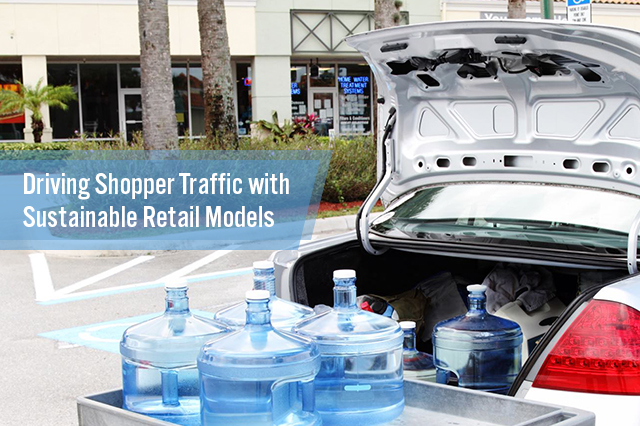
Nitheesh NH
Introduction
Sustainability is becoming ever more central to retail as increasing numbers of consumers pay attention to how products are made, and purchasing decisions are increasingly influenced by ethical and sustainability factors. The trend is supporting shifts by consumers to alternatives such as resale and rental, and it is prompting retailers to respond with changes across the supply chain, from how they source to helping consumers recycle.
Coresight Research’s coverage of sustainability has recently included our report on the role of cleantech in retail and our deep dive on the importance of sustainability and social values in the luxury market. With this report, we continue our coverage of sustainability with a case-study on Watermill Express, a supplier of drinking water and ice whose model based on offering a more environmentally friendly way to buy water than single-use small bottles from regular retail stores: Customers bring their own reusable containers to a dispensing location, reducing the packaging waste associated with bottled water; and the company uses a 12-step process to purify water from a municipal water source, reducing its environmental impact.
In this report, we analyze the results of a survey of Watermill Express customers, to understand their shopping behavior and characteristics. We begin by discussing the growing importance of sustainability in retail and the scale of the challenge to “green” the bottled water industry.
Sustainability Goes Mainstream
Survey after survey suggests that consumers, and often younger consumers, are interested in environmental responsibility across the retail supply chain. According to a 2018 US survey by business applications firm CGS, half of males aged 18-34 and women aged 18-24 and 34-55 consider ethical manufacturing a buying factor. CGS found that 40% of respondents expressed interest in the ethics of products. Half of millennials, 45% of Gen Xers and 40% of baby boomers said they would pay more for a sustainable product.
Similarly, a 2018 survey by the Natural Marketing Institute found 64% of millennials and 51% of Gen Xers would buy environmentally friendly and sustainable products if they were more available. The Natural Marketing Institute found that millennials are 28% more likely than others to say they will pay more for sustainable and ethically produced products.
And 2019 Coresight Research survey data also suggests interest in sustainability by age peaks among the youngest and oldest adult age groups.
[caption id="attachment_92530" align="aligncenter" width="720"]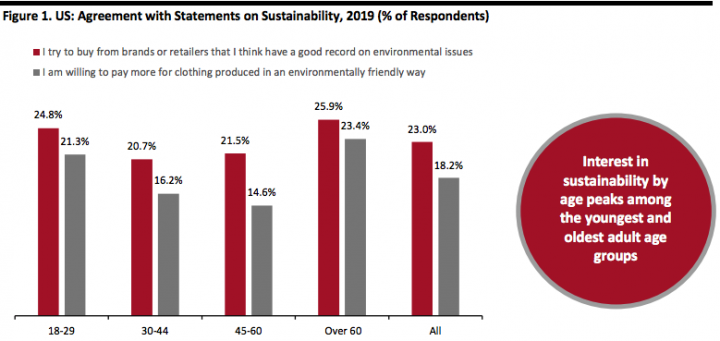 Base: 1,732 US Internet users aged 18+
Base: 1,732 US Internet users aged 18+
Source: Coresight Research[/caption] Plastic waste is rapidly moving up the sustainability agenda. According to nonprofit organization the 5 Gyres Institute, cited by National Geographic, in 2015 there were 5.25 trillion pieces of plastic debris in the oceans, with 269,000 tons floating on the surface and four billion plastic microfibers per square kilometer littering the ocean. National Geographic also estimates that 79% of product packaging ends up in landfills, and predicts that by 2050 there will be 12 billion metric tons of plastic in landfills. According to the 5 Gyres Institute, a 2018 Mintel study found that 29% of those who buy bottled water recognize that this habit is bad for the environment. And, one in four people stopped buying bottled water because the containers are made of plastic. The US Bottled Water Industry: Scale and Impact In the US, bottled water is a growing business — despite apparently growing concerns about the environmental impact. According to the International Bottled Water Association (IBWA), in 2017: A Watermill Express location
A Watermill Express location
Source: Company website[/caption] Understanding Who Shops More Sustainably: Older Millennials and Family-Lifestage Shoppers Dominate the Watermill Express Customer Base First, what types of consumers buy from Watermill Express instead of shopping in store for regular bottles of water? Our survey found fully 79% of Watermill Express customers are in the broad 26-55 age group. At the lower end, this segment includes millennials who are seeing their incomes grow and are establishing households and who, it is often suggested, are more environmentally conscious. At the core of this 26-55 age group lies the more established family-lifestage demographic — meaning many in this age group will be managing substantial family budgets across a number of store formats and categories. From our survey data, we estimate the average Watermill Express customer is aged 39.7 years, with relatively little difference between Las Vegas (40.5 years) and Houston (38.8 years). [caption id="attachment_92532" align="aligncenter" width="720"]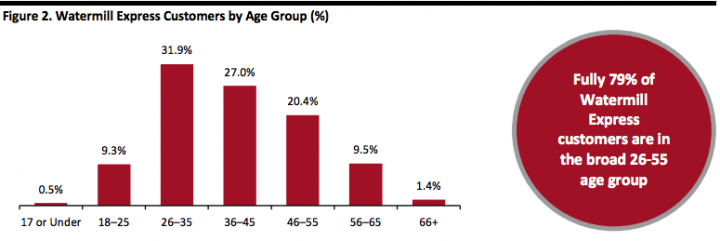 Base: 814 Watermill Express customers across seven locations
Base: 814 Watermill Express customers across seven locations
Source: BodeTree/Coresight Research[/caption] Consumer expenditure survey data from the US Bureau of Economic Analysis confirms that those aged mid-20s to mid-50s are higher-spending groups: This data shows average per-household spending in 2016–17 (latest data) was $53,390 for those headed by a 25-34 year old, $66,729 for those households headed by a 35-44 year old and $71,548 for those headed by a 45-54 year old. Average per-household spending declines with age thereafter. One-Third of Watermill Express Customers Switched from Supermarkets or Other Large Stores We asked respondents where they used to buy water or ice before they started buying from Watermill Express. Three in 10 said they had switched from a supermarket or another large store, and one in 10 had switched from a convenience store. These findings imply that Watermill Express’s “refill” model has attracted substantial numbers of shoppers from conventional bottled water sold in retail stores — and this could reflect environmentally concerned shoppers switching to an alternative that generates less plastic waste. By region, switching from a convenience store was more widespread in Las Vegas than in Houston. Switching from supermarkets was less common among Las Vegas customers than it was in Houston. The findings also confirm a degree of loyalty to the brand, with four in 10 saying they were previously buying from this brand at another location. [caption id="attachment_92533" align="aligncenter" width="720"]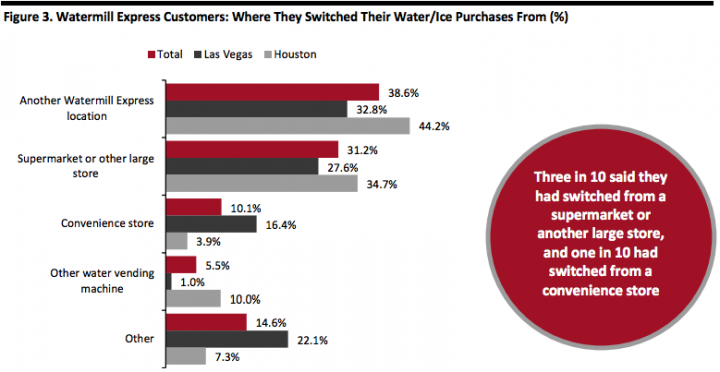 Base: 814 Watermill Express customers across seven locations
Base: 814 Watermill Express customers across seven locations
Source: BodeTree/Coresight Research[/caption] Watermill Express Customers Are Very Frequent Visitors Watermill Express customers are typically high-frequency visitors. As shown below, almost half visit multiple times per week. From this survey data, we estimate the average customer visits Watermill Express almost six times per month, based on estimated figures for some frequency ranges such as “more than once per week” and “less than once a month.” We estimate customers in Las Vegas visit Watermill Express an average 6.8 times per month and Houston customers visit 5.1 times per month. [caption id="attachment_92534" align="aligncenter" width="720"]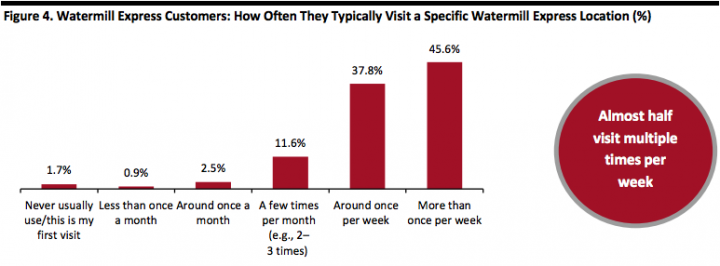 Base: 814 Watermill Express customers across seven locations
Base: 814 Watermill Express customers across seven locations
Source: BodeTree/Coresight Research[/caption] Watermill Express Drives Traffic to Shopping Centers Our survey found that Watermill Express also drives traffic to shopping centers. We asked those buying water or ice why they made a trip to a shopping center and fully 78% said that it was to visit Watermill Express. Only 22% said it was to visit another establishment. Our data suggests Watermill enjoys stronger appeal in some regions: among Las Vegas customers, 91% said their primary reason for the trip was Watermill; among Houston customers, 65% stated Watermill was the driver. [caption id="attachment_92535" align="aligncenter" width="720"]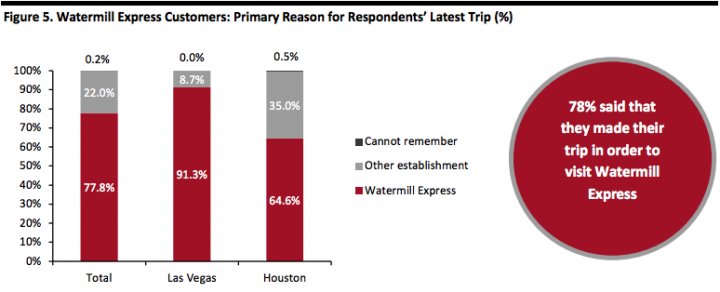 Base: 814 Watermill Express customers across seven locations
Base: 814 Watermill Express customers across seven locations
Source: BodeTree/Coresight Researche[/caption] One-Third of Watermill Express Customers Visited Other Stores on Their Latest Trip The traffic that Watermill Express generates extends to other retailers in the centers in which it operates, confirming that sustainable models outside of conventional retail formats can drive shopper traffic and cross-shopping at nearby retail stores. Some 30.3% of Watermill Express customers said they had visited, or expected to visit, another establishment at the shopping center they were visiting on the day we surveyed them. Coupled with the finding that 78% of customers made their shopping trip specifically to visit Watermill Express (see above), this suggests the brand drives significant volumes of regular traffic to nearby retailers and service providers. Our survey asked respondents about the shopping trip that they were making at the time of the survey only, so the high frequency of visits to Watermill (shown above) helps explain why a minority of customers visited other establishments on their latest trip: with an estimated average six visits per month, many consumers will not see a need to visit other stores on each visit. Over an average six trips per month, we expect the monthly cross-shopping average to be considerably higher than the per-trip figure of 30%. On the assumption that 30% of all Watermill Express customers cross-shop on each trip and based on an average six visits per month, our data suggests the average Watermill Express customer makes around 1.8 cross-shopping trips to other establishments in the same shopping center per month. [caption id="attachment_92536" align="aligncenter" width="524"] Base: 814 Watermill Express customers across seven locations
Base: 814 Watermill Express customers across seven locations
Source: BodeTree/Coresight Research[/caption] Key Insights Watermill Express is an example of a sustainability focused brand attracting shoppers, in turn driving shopper traffic to nearby stores. Many Watermill Express shoppers have switched from conventional retail channels: Three in 10 of the brand’s customers we surveyed said they had switched from a supermarket or another large store, and one in ten had switched from a convenience store. These findings imply the Watermill Express “refill” model has attracted substantial numbers of shoppers from more conventional bottled water formats. Sustainable models can drive shopper traffic: Our survey data confirms that sustainable models can drive shopper traffic and cross-shopping at nearby retail stores. The survey found Watermill Express locations attract frequent shopper visits; and 30% of Watermill Express customers claimed to cross-shop at other stores or service providers on their latest trips. Once we average over a multitrip period, we expect cross-shopping rates to be meaningfully higher. Survey Methodology A total of 814 respondents were surveyed face to face in seven locations in Las Vegas and Houston, between December 2018 and February 2019. Total respondent numbers were split 402 in Las Vegas and 412 in Houston. The findings represent the views of those who bought from Watermill Express. Total figures and the breakdowns by region have a margin of error of 5% with a 95% confidence interval.
 Base: 1,732 US Internet users aged 18+
Base: 1,732 US Internet users aged 18+Source: Coresight Research[/caption] Plastic waste is rapidly moving up the sustainability agenda. According to nonprofit organization the 5 Gyres Institute, cited by National Geographic, in 2015 there were 5.25 trillion pieces of plastic debris in the oceans, with 269,000 tons floating on the surface and four billion plastic microfibers per square kilometer littering the ocean. National Geographic also estimates that 79% of product packaging ends up in landfills, and predicts that by 2050 there will be 12 billion metric tons of plastic in landfills. According to the 5 Gyres Institute, a 2018 Mintel study found that 29% of those who buy bottled water recognize that this habit is bad for the environment. And, one in four people stopped buying bottled water because the containers are made of plastic. The US Bottled Water Industry: Scale and Impact In the US, bottled water is a growing business — despite apparently growing concerns about the environmental impact. According to the International Bottled Water Association (IBWA), in 2017:
- US bottled water volumes totaled 13.71 billion gallons, up 7% from 2016. This cemented bottled water as the number one US beverage category by volume, a position that the category first achieved in 2016.
- By volume (gallons), bottled water accounted for 23.9% of all US beverages in 2017, versus 22.3% for second-place carbonated soft drinks.
- US per capita consumption of bottled water exceeded 42 gallons in 2017.
- Bottled water producer revenues in the US reached $18.56 billion in 2017, up 8.8% from 2016.
 A Watermill Express location
A Watermill Express locationSource: Company website[/caption] Understanding Who Shops More Sustainably: Older Millennials and Family-Lifestage Shoppers Dominate the Watermill Express Customer Base First, what types of consumers buy from Watermill Express instead of shopping in store for regular bottles of water? Our survey found fully 79% of Watermill Express customers are in the broad 26-55 age group. At the lower end, this segment includes millennials who are seeing their incomes grow and are establishing households and who, it is often suggested, are more environmentally conscious. At the core of this 26-55 age group lies the more established family-lifestage demographic — meaning many in this age group will be managing substantial family budgets across a number of store formats and categories. From our survey data, we estimate the average Watermill Express customer is aged 39.7 years, with relatively little difference between Las Vegas (40.5 years) and Houston (38.8 years). [caption id="attachment_92532" align="aligncenter" width="720"]
 Base: 814 Watermill Express customers across seven locations
Base: 814 Watermill Express customers across seven locationsSource: BodeTree/Coresight Research[/caption] Consumer expenditure survey data from the US Bureau of Economic Analysis confirms that those aged mid-20s to mid-50s are higher-spending groups: This data shows average per-household spending in 2016–17 (latest data) was $53,390 for those headed by a 25-34 year old, $66,729 for those households headed by a 35-44 year old and $71,548 for those headed by a 45-54 year old. Average per-household spending declines with age thereafter. One-Third of Watermill Express Customers Switched from Supermarkets or Other Large Stores We asked respondents where they used to buy water or ice before they started buying from Watermill Express. Three in 10 said they had switched from a supermarket or another large store, and one in 10 had switched from a convenience store. These findings imply that Watermill Express’s “refill” model has attracted substantial numbers of shoppers from conventional bottled water sold in retail stores — and this could reflect environmentally concerned shoppers switching to an alternative that generates less plastic waste. By region, switching from a convenience store was more widespread in Las Vegas than in Houston. Switching from supermarkets was less common among Las Vegas customers than it was in Houston. The findings also confirm a degree of loyalty to the brand, with four in 10 saying they were previously buying from this brand at another location. [caption id="attachment_92533" align="aligncenter" width="720"]
 Base: 814 Watermill Express customers across seven locations
Base: 814 Watermill Express customers across seven locationsSource: BodeTree/Coresight Research[/caption] Watermill Express Customers Are Very Frequent Visitors Watermill Express customers are typically high-frequency visitors. As shown below, almost half visit multiple times per week. From this survey data, we estimate the average customer visits Watermill Express almost six times per month, based on estimated figures for some frequency ranges such as “more than once per week” and “less than once a month.” We estimate customers in Las Vegas visit Watermill Express an average 6.8 times per month and Houston customers visit 5.1 times per month. [caption id="attachment_92534" align="aligncenter" width="720"]
 Base: 814 Watermill Express customers across seven locations
Base: 814 Watermill Express customers across seven locationsSource: BodeTree/Coresight Research[/caption] Watermill Express Drives Traffic to Shopping Centers Our survey found that Watermill Express also drives traffic to shopping centers. We asked those buying water or ice why they made a trip to a shopping center and fully 78% said that it was to visit Watermill Express. Only 22% said it was to visit another establishment. Our data suggests Watermill enjoys stronger appeal in some regions: among Las Vegas customers, 91% said their primary reason for the trip was Watermill; among Houston customers, 65% stated Watermill was the driver. [caption id="attachment_92535" align="aligncenter" width="720"]
 Base: 814 Watermill Express customers across seven locations
Base: 814 Watermill Express customers across seven locationsSource: BodeTree/Coresight Researche[/caption] One-Third of Watermill Express Customers Visited Other Stores on Their Latest Trip The traffic that Watermill Express generates extends to other retailers in the centers in which it operates, confirming that sustainable models outside of conventional retail formats can drive shopper traffic and cross-shopping at nearby retail stores. Some 30.3% of Watermill Express customers said they had visited, or expected to visit, another establishment at the shopping center they were visiting on the day we surveyed them. Coupled with the finding that 78% of customers made their shopping trip specifically to visit Watermill Express (see above), this suggests the brand drives significant volumes of regular traffic to nearby retailers and service providers. Our survey asked respondents about the shopping trip that they were making at the time of the survey only, so the high frequency of visits to Watermill (shown above) helps explain why a minority of customers visited other establishments on their latest trip: with an estimated average six visits per month, many consumers will not see a need to visit other stores on each visit. Over an average six trips per month, we expect the monthly cross-shopping average to be considerably higher than the per-trip figure of 30%. On the assumption that 30% of all Watermill Express customers cross-shop on each trip and based on an average six visits per month, our data suggests the average Watermill Express customer makes around 1.8 cross-shopping trips to other establishments in the same shopping center per month. [caption id="attachment_92536" align="aligncenter" width="524"]
 Base: 814 Watermill Express customers across seven locations
Base: 814 Watermill Express customers across seven locationsSource: BodeTree/Coresight Research[/caption] Key Insights Watermill Express is an example of a sustainability focused brand attracting shoppers, in turn driving shopper traffic to nearby stores. Many Watermill Express shoppers have switched from conventional retail channels: Three in 10 of the brand’s customers we surveyed said they had switched from a supermarket or another large store, and one in ten had switched from a convenience store. These findings imply the Watermill Express “refill” model has attracted substantial numbers of shoppers from more conventional bottled water formats. Sustainable models can drive shopper traffic: Our survey data confirms that sustainable models can drive shopper traffic and cross-shopping at nearby retail stores. The survey found Watermill Express locations attract frequent shopper visits; and 30% of Watermill Express customers claimed to cross-shop at other stores or service providers on their latest trips. Once we average over a multitrip period, we expect cross-shopping rates to be meaningfully higher. Survey Methodology A total of 814 respondents were surveyed face to face in seven locations in Las Vegas and Houston, between December 2018 and February 2019. Total respondent numbers were split 402 in Las Vegas and 412 in Houston. The findings represent the views of those who bought from Watermill Express. Total figures and the breakdowns by region have a margin of error of 5% with a 95% confidence interval.